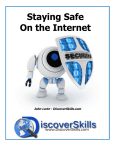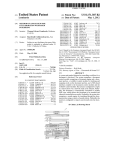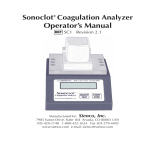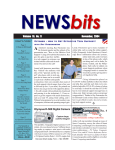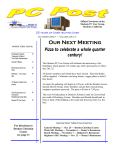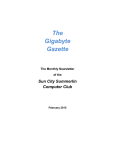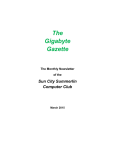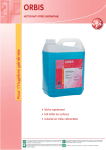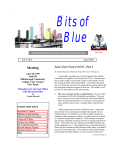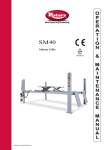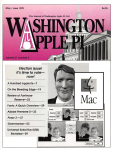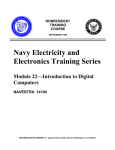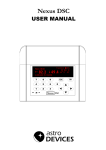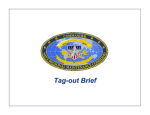Download Adobe - The Rochester Computer Society, Inc
Transcript
Review of Windows XP Part 3 by Warren Ganter R Rochester Computer Society, Inc. ecap: Having won a copy of Windows XP at a recent meeting of Rochester Computer Society, I am in the process of writing the required review of the product. In Part 1 I reviewed some preliminary information about XP, and discussed my situation with regard to upgrading my present computer or purchasing new. In Part 2, the decision was made and I began procurement and construction of a new machine. I also said that beginning with the construction phase of this review I would be using a “diary” format to report progress chronologically. One question was pending at the end of Part 2: Does the video card operate on 1.5 volts? Higher voltage may damage the motherboard (MB). The Construction Continues March 1, 2002: To solve the video card question I called Pine Technologies and asked about the voltage. I was assured the card operated at 1.5 volts. Good news! So I installed the card in the AGP slot. One more component out of the way. Next, using the aforementioned anti-static wires (see Part 2), I removed the 20gig hard drive from its protective packaging, set the jumper to “Dual-Master” and installed the drive into the case. It will be paired with a CD-RW drive on IDE slot number1. March 2-4: Waiting for more components to arrive via UPS. In the meantime I explored Western Digital’s Web site. A lot of information is available. I also examined the case that I received as part of the Barebones package. The power on switch is located on the rear of the case. I would like to mount a new switch on the front panel. There is space on the plastic front panel, but I will have to cut or diepunch a hole in the metal chassis immediately behind the panel. The motherboard has 2 USB ports at the rear and 2 at the front end of the board. However, there is no provision in the front panel for USB connectors. The front of the chassis behind the plastic front panel is pierced so that any section that needs to be removed when inserting a drive can easily be removed by twisting the metal section with a pair of pliers. To do this one must release the front panel snaps and pull the panel away from the case. March 5: Went to UPS.com and entered the tracking number for the components that I am waiting for. This is great. I clicked on Tracking, entered the number in the box, clicked Go and was presented with a complete history of the movement of the package from its source in Illinois, a stopover in Buffalo, NY and finally to a location in Henrietta, NY. It arrived in Henrietta just after 5 p.m. today, so I will look for it to be delivered tomorrow. March 6: UPS delivered a Sony CD-RW and a 1.44 MHz floppy drive. I Had planned to use existing CD-ROM and floppy drives that I had on hand in a couple of obsolete computers that take up space in the house, but who can resist sale prices with rebates? And this is an all new machine—why put some old junk in with this nice new stuff? I installed the floppy drive and CD-RW. The hard drive that I installed earlier was set for “master” and plugged into IDE #1 connector on the motherboard. I set the CD-RW at ‘master’ and plugged it into IDE #2. Hey, we are almost done. Have I forgotten anything! You computer gurus are The RCSi Monitor / May 2002 1 probably smiling, waiting to see what I will do next. I am not quite ready to apply power. Must do a little more reading and double checking on the procedure. During the evening on March 6th I received an email from the mail order house! They have followed every order with offers for additional items. They also do not miss a chance to suggest additional items when you placing an order on the ‘phone. But they are not pushy. They just suggest and offer their “specials.” This email offered a special price on a Romtec Trios IDE hard drive selector. I had noticed it when online with the mail order house. It allows you to have three hard drives in your computer. The device is basically a switch box that switches both power and signal so that only one hard drive is active at any given time. This allows different operating systems on each of the hard drives, or it can be configured for 3 different users, each with their own hard drive, or whatever. To change hard drives, you must totally shut off the computer, select another drive with a pushbutton, then turn on the power switch to boot the newly selected drive. This seemed to solve the problems that I mentioned early in this review—that I want to continue running several DOS applications, and that some of the programs that I run under Windows 95 may not work with Windows XP. Solution: March 7: The Solution! Order the Trios unit and after I get the new machine operating properly, install the hard drive from my current machine in the new one. Great! Problems solved—I hope! I called early in the day and ordered the unit by ‘phone while online, after which I 2 downloaded the rebate form. I chatted with the salesperson and said, “You must have quite a large staff. I never have to wait on the ‘phone.” He replied, “We have over 200 people answering the ‘phones. We are a twobillion a year company.” I was impressed. March 8: I went online to the UPS site, entered my tracking number, and found that the order had arrived in Henrietta about 8 p.m. What fast service! March 11: The Trios unit was delivered. It comes with all the cables necessary to make the hookup. It can be used to manage either two or three drives. It mounts in a 5 1/4 bay. The front panel consists of three buttons to select drives. Only one can be depressed at a time. Press one and the previously depressed button pops up.... Installation is simple. Mount the unit with 4 screws (provided), connect the cables according to the instructions in the manual, and you are ready to go. The only thing I did not like was that the case is plastic. The screws will selfthread into pilot holes in the case. OK, I guess! The advantage is that the device may be used internally or externally. I will probably install it tomorrow. March12: I had to rearrange the drives already installed so that the Trios cables had some orderly connection to the drives and motherboard. After all the cables were installed,.the inside of the computer looked like a rat’s nest. They get in the way of trying to reach any thing on the MB. I also installed a second hard drive that I had on hand. Hopefully there is a version of Windows on it. Remember that drive number one is brand new with nothing on it. If number 2 does not boot I will have to reboot, enter the CMOS, make the CD-RW drive the boot drive, and then proceed with the XP installation on drive number one. The RCSi Monitor / May 2002 Finally, I am ready to attempt a startup. The front panel is back in place, mouse attached and keyboard.... Whoops! The new MB has a mini 6-pin socket and the old keyboard has a 5-pin. Now I need an adaptor or a new keyboard.. The test is postponed until that decision is made. March 13: An adapter is $7-10 locally ($3 online). I can buy a basic keyboard with the mini connector for about $8. I decided I do not want that two inch long adaptor sticking out the back of the machine and if I am to buy a new keyboard, I would spend a little more and get the proper one. I like a touch with fairly high key resistance. I found an IBM keyboard locally that seems just right, so I bought it. More money! You can’t take it with you, Right? March 14: Downloaded a driver for the keyboard (17+ megs. What a driver this must be). March 15: I am ready to throw the switch, but first I had to call our friend, Nick on his Friday evening program on TV channel 9. I explained briefly what I had done and was a little hesitant to turn on the power. He basically said. “Do it. If it works, Fine! If not, fix it and try again.” First Power up: March 16: With Nick’s words of encouragement I prepared to make the trial run. All connections looked OK. I set the Trios hard drive selector to drive 2 (a drive that I had from an earlier computer), pushed the power switch and... AMAZING! There on the monitor was the opening screen for Windows for Workgroups 3.11. I must have done something right. I looked around; checked directories. All old stuff! I put a disk in the A: drive and read the directory. A: drive is AOK! I tried a disc in the CD drive with no results. I will check that out tomorrow. Second Power up: March 17: OK, no more stalling! I set the ROMTEC Trios hard drive selector to drive 1 (the new hard drive), pushed the power switch, hit the Delete key to open the BIOS, set the time and date; set the CD-RW to boot first; set auto detect the hard drive; then finally, hit Escape, Save?, and Yes. I was prompted to insert a disc in the CD drive. I did so and was presented with several pages of Microsoft terms and conditions which I accepted. Next I was offered a option to partition the hard drive. I selected a partition of 8 gigs. It was created I then designated the remaining unpartitioned space (12 gigs) for installation of Windows XP. I received a message saying not enough space to install XP, so I deleted the partition and allowed the install to begin on the total unpartitioned 20 gig drive. I was prompted to select the file system, either FAT 32 or NTFS ( the Windows NT file system). You can select FAT32 and upgrade to NTFS later, but you can not convert back to FAT32 later. I chose FAT32 which is appropriate for a hard drive smaller than 32 GB. The format began as C drive on “disk 0 at ID 0 on bus 0 on atapi (MBR)” whatever all that means. During the formatting a series of XP features was displayed on the screen. Format was complete in about 10 minutes. Next, Setup copied startup .files to hard drive “windows installation folders.” This took about 5 minutes. Finally the XP Windows opening screen appeared temporarily. Then Setup continued while more features were presented. Some of the prompts during setup were: Select date format and language, enter the 25 character Product Key found on the XP CD-ROM folder, and enter an administrator password. Also, a name for The RCSi Monitor / May 2002 3 my computer was provided during the setup. The name given was WARREN—followed by a series of alpha characters and numerals. It did not advise what this name was to be used for. More features were continually displayed I was prompted to choose either “Domain or Workgroup.”I chose Workgroup based upon the rational given. I do not remember the exact difference. It is difficult to take notes while installing an operating system. The last steps in the Setup were to install the Start Menu components. Then Windows advised it was going to adjust monitor screen resolution. The Setup took about 35 minutes. The entire install took about 1½ hours. It was a very friendly procedure. Most everything was explained before it happened. It was accomplished without any glitches. The XP opening screen finally appeared, complete with the Start Menu button. No!, I did not attempt to explore the new system and files that were installed. It was way past lunchtime and I had some other things to do on Sunday afternoon including writing this segment of the review while it is fresh in my mind. Enough for now! Getting Familiar With XP: March 18: I turned the computer on and it booted up quickly. I had to type my “administrator” password to continue. This is a nuisance when there is only one user. There is probably a way to void the prompt. I clicked the Start button. This produced a dual pane window. The left pane presented a menu of programs: Internet Explorer Outlook Express SnagIt 5.0 Windows Media Player Files and Settings Transfer Wizard MSN Explorer 4 Tour Windows XP The right-hand pane provides access to common Windows folders such as My Documents, My Pictures, My Music, Favorites, My computer, Control Panel, Help and Support, Search, Run and others. The reason for the Start concept is to clean up the desktop. This desktop shows only some fluffy clouds over a rolling landscape with the Recycle Bin in the lower right corner the Start button in the lower left corner of the Task Bar. If one prefers the classic Windows style for the desktop and Start menu, it can be obtained by clicking Properties, and choosing Classic Start menu. I attempted to relocate or hide the Task Bar by dragging with the mouse but it did not cooperate. I opted to take the XP tour. I was given the choice of taking the tour with music and animation or just plain text. I hooked up loudspeakers from my other computer and proceeded with the tour. Ugh! Too much background music! It was louder than the voice that was describing the features. This is common practice today whether it is radio, TV or a computer file. Gotta have background music! The audio techs have to earn their salaries. This eternal background music (noise) is very annoying to those who suffer any hearing loss. Oops! I’m off the subject. Sorry! In XP, when you open a program for the first time, its icon is automatically added to the Start menu. One other item appears at the bottom of the left pane labeled All Programs. Clicking on that lets you access typical Windows menus and installed applications. I browsed around some of the other folders but decided to shut down until I had installed the software and drivers that came with the hardware that I bought and in- The RCSi Monitor / May 2002 Listen on Saturdays from 12:20 to 2 pm on WHAM 1180 AM stalled. So far, there is nothing on the main hard drive except the operating system. March 20: I replaced the second hard drive that I mentioned earlier with one I had on hand from two computers back. I also installed another hard drive as a slave on IDE #2 with the CD-RW. My configuration now stands at two hard drives on the Trios Selector (either one bootable) and one slave to be used for data with either of the bootable drives. This time when I turned on the power I received an error message that I should remove any newly installed drives because there was a problem. So, I pulled the connectors until I can find what that is all about. I re-booted after selecting the new drive with XP installed It loaded OK this time. If you want to browse using My Computer click Start, and My Computer in the right hand panel. Everything is displayed as picture icons in an HTML format. You can go back and forth using the Back and Forward arrow buttons at the top of the screen. This is a vast improvement over “X”ing out windows in Windows 9x. Of course you can change the icons into a list by clicking on View in the Menu bar. If you are inclined to use DOS to see what’s what in your computer, drop to the command level in XP and browse a little. Do this by clicking Start, Run. Enter “cmd” and press Enter. You will drop to the command level at C:\Docu-ments and Settings\ Administrator. Type “CD..” and hit Enter. Then do it again to drop to the C:\ (root) folder. Now do a DIR (Have we come so far with Windows that some readers may not know the basic DOS commands?) If so, I will explain as we go. Type DIR or dir (it does not matter) and hit Enter. From this point on I will use this symbol for the Enter key <<. A list of files will display including Windows, Documents and Settings, Program Files and a few others that XP installed. Now, to really see everything, type “tree”<<. All the folders and files will display so fast you will not be able to read them until scrolling stops. However, if you type “tree |more” you can scroll through with ease. Hit the Enter key to scroll a line at a time or the space bar to scroll a page at a time. Hold the Enter key down and you will get a slow scroll. You can use the tree command at any DOS level. For non-DOS users, in the “tree|more” command, the”|” is the backslash key “\” shifted.. “more” is a DOS command to scroll a page at a time. To leave the (DOS) command level, type “exit”<<. I refer to the command level as “DOS.” Whether it is true DOS or not remains to be seen. When using XP a window pops up daily reminding the user to “activate” the XP installation. This is different from registration. Activation is designed to stop software The RCSi Monitor / May 2002 5 piracy. I will report the procedure later when I do it. March 27: Yes, a week passed without any new revelations about XP or the the new computer. Today I installed some additional memory. When I booted the system I heard a series of beeps. It did not boot. I checked inside and found the Ram modules were not completely seated in the DIMM slots. I finally managed to seat the modules and engage the clamps that hold them in place. This should not be so difficult to do. The system booted OK this time. Next I installed an Intel 56K internal PCI modem. When I booted, Windows XP found the new modem and prompted for the CD disc. The disc is labeled for W95 through Win XP. I installed the disk. The install procedure continued. A window popped up warning against continuing with the installation because the XP driver has not been digitally signed by Microsoft (MS).The warning further stated that if I continued, the computer could be damaged immediately or in the future, so I quit. I will now attempt to go online with my other computer and find a MS digitally signed driver. This is a nuisance. I have an Intel modem with a disc that states it is compatible with XP but I am afraid to use it. Ugh! On the other hand, why not use the CD disc that came with XP when prompted. I right-clicked My Computer, Properties, Hardware, Device Manager and Modems Under the modems menu I found PCI Simple Communications Controller as the name for my modem. I right-clicked that name, then Properties. The resulting screen gave the following information: Device type–Modems, Manufacturer-Unknown, Location–PCI slot 6-bus2, Device 3, Function (0), and the words, “Drivers for this device 6 not installed.” This was all under the General tab at the top of the window. Next I clicked the Driver tab. It revealed driver unknown and not digitally signed. There were also buttons to Update the driver, Uninstall and to View details about a properly installed driver. There was one more tab, Resources. I clicked it and was told, “This device is not using any resources because it has a problem.” ( I knew that). Overall, the Device Manager will display all you want to know about any hardware that is installed. It even tells you that it is working properly, or not. I clicked on the Update Hardware button and was taken to the Hardware Update Wizard. From there I went through the install procedure again, this time using the CD disc that came with XP. No driver could be found, so as I mentioned above, I will try to find one that is digitally signed my Microsoft on the Internet. (To be continued) Fire In The Valley: The Making of the Personal Computer Second Ed. by Paul Freiberger and Michael Swaine Reviewed by Jim Scheef T Danbury Area Computer Society he first edition of this book was published in 1984 and is a classic of personal computer history. The second edition updates many chapters and adds several significant stories about the industry from ‘85 to the end of the Nineties. The authors make each segment interesting and eventually link everything together. While Fire In The Valley is ostensibly the story of the computer industry that grew up in Silicon Valley, it begins at the beginning with the first computer designer and the The RCSi Monitor / May 2002 first programmer. Charles Babbage worked most of his life designing the “Analytical Engine,” a mechanical computer that could perform integrals. Babbage’s patron was Lord Byron, the poet, and his assistant was Lord Byron’s daughter, Augusta Ada Byron, the future Lady Lovelace. Ada was the first programmer, as she defined the procedures needed for the analytical engine to solve mathematical problems. The reason I’m telling you all this is that I think Babbage and Steve Wozniak would have been best friends. See if you don’t agree. Fast forward to 1943 with the world at war: the U.S. Navy needs to compute artillery trajectory tables. At that point in time a “computer” was (typically) a young woman with a Monroe calculator. The state of the art for automated computing was a room-sized machine using mechanical relays to perform arithmetic operations. Two men at the Moore School of Engineering proposed an all-electronic calculating machine. The ENIAC was completed too late for the war effort but proved the concept and moved computing forward. Of course ENIAC was years before a series of events made it possible for ordinary people to own their own computers. It is that series of serendipity that produced the personal computer and the information revolution that is the key story of Fire In The Valley. I read the first version of this book back in the late 80's and have read many books on industry history since then, and I am amazed at how complete this book really is. From the development of the first microprocessor by Ted Hoff at Intel (for a Japanese calculator), to Ed Roberts and the Altair 8800 (and the industry it spawned), to Jobs and “The Woz” and the emergence of Apple as a Fortune 500 company. Not to mention the growth of the software companies. Bill Gates was not the only person to realize that software was the key to making personal computers useful. The book covers the many failures as well. IMSAI, ComputerLand, VisiCalc, Radio Shack Computer Centers, CP/M and Osborn Computers are all gone—and all for different reasons. There were other failures and fiascos like the Apple III and Next Computers. The second edition updates many of these stories with what happened in the 90's. Like how come Steve Jobs is still rich after the failure of Next Computer? Hint: it has more to do with movies than the fact that he sold Next to Apple a few years ago so it could become the basis of OS-X. Who could forget the browser wars of the late 90's? From the day Microsoft became the standards setter, Gates has had the fear that The RCSi Monitor / May 2002 7 “some clever hacker” could undo it all. Of course this fear was based on what Gates himself had done to build Microsoft, and when Marc Andreessen created Mosaic and then morphed it into Netscape, Gates saw his nightmare unfolding. Of course we are still living the end-game of this particular story with the Microsoft anti-trust case. Ok, so what’s missing? Well, I would have liked to see more about how IBM blew it with the PS/2 computer series and the OS/2 operating system. This was a turning point in the computer industry. Perhaps the best feature of this book is that each story is related in enough detail to give you a sense of what is happening without bogging you down in minutia. If you can only read one book on the history of the personal computer, this is the book. Read it! Published by McGraw-Hill, 2000, paper back, 463 pages including index. From the March 2002 issue of DACS, the newsletter of the Danbury (CT) Computer Society, Inc. Jim Scheef is the Mad Scientist at Telemark Systems Inc. where he develops custom software using Visual Basic and SQL Server and provides networking services using Windows NT/2000. He has been a DACS member since the day DOG became WC/MUG. Caution! Don’t Let Brilliant Hijack Your PC by David Coursey, AnchorDesk URL: http://www.zdnet.com/anchordesk /stories/story/0,10738,2859775,00.html rilliant Digital Entertainment is the latest in a string of companies that seem to think Internet users are stupid. In this case, stupid enough to let Brilliant take over your computer for its own gain—without compensating you. Don’t let them! B 8 Here’s the story: Brilliant has been distributing its 3D advertising technology along with Kazaa’s file-swapping software since last fall. But recently Brilliant started sending out additional software that would turn every computer running Kazaa into a node on Brilliant’s own network. We know this because ZDNet’s John Borland uncovered the story yesterday while reading a federal securities filing in which Brilliant described its plan to use end users’ computers for distribution and file storage. It might also siphon off your unused processing power to have your computer do work on behalf of Brilliant’s clients. Brilliant’s clandestine network is based on a piece of software called “Altnet Secureinstall,” which is bundled with the Kazaa software. That technology can connect to other peer-to-peer networks, ad servers, or file servers independently of the Kazaa software, and can be automatically updated to add new features. While Brilliant promises that customers will be given a chance to opt-in (or not, I suppose) before the network is turned on, and that some compensation will be offered, the company is under no obligation to do so. That’s because buried in the fine print of the Kazaa user agreement is the following: “You hereby grant (Brilliant) the right to access and use the unused computing power and storage space on your computer/s and/or Internet access or bandwidth for the aggregation of content and use in distributed computing. The user acknowledges and authorizes this use without the right of compensation.” You have to agree to those terms before you can use the Kazaa file-swapping service. My bet is that the company really will offer some trifling incentive for people to opt The RCSi Monitor / May 2002 in—forever—before turning on its network. But that deal is one-sided: You have no way of knowing what your excess bandwidth and processor power is actually worth. Maybe Brilliant should give everyone who opts-in a share of its stock so everyone can share in the wealth the company hopes to create. Beyond questions of propriety and security—is the software safe from hackers?— you have to wonder: How are we supposed to trust Brilliant when they’ve already snuck their software onto millions of machines? Brilliant is not the only company trying to pull some version of this trick on users. Kontiki and Red Swoosh are also in the business of using other people’s machines and bandwidth to distribute their own (and their clients’) content. I don’t know enough about these two companies to toss them into the same pile with Brilliant. But I suspect they are very close. Maybe someday a company like Brilliant will be honest with us, explaining its intentions up-front, and giving users a chance to opt-in and receive fair compensation in return if they do. When that happens, maybe we will decide to say yes to the offer. I can’t imagine why we would, given the privacy and other risks involved, but at least we should be given the chance to consider the offer. But since Brilliant has already missed the opportunity to be candid about its plans —and the software it’s installed on millions of users’ machines—I urge everyone to dump Kazaa and, in the process, send Brilliant packing. In doing so, you’ll be protecting your computer, the Internet, and sending a message to slimeball companies about what is—and isn’t—acceptable behavior. Writing Inside and Out by Steve Bass I Pasadena IBM Users Group have a comfy spot on both sides of the fence. I get the pleasure of writing for a magazine that’s big enough for me not to worry that I’ll say something dumb. PC World provide tons of background support—first, second, and technical editors, copy editors, fact checkers, and even attorneys. At the other end of the spectrum are user group newsletters. Writing in PIBMUG is more freewheeling. I can write about any topic, something that strikes me on the spur of the moment. (PCW wants a four month stack of story topics.) And unlike PC World, I don’t have anyone watching my language, fretting over (and often removing) my voice, and roping me into a set amount of space. PC World’s Home Office column is roughly 650 words, less the “Where to Buy,” the spot where I supply details so the reader can get in touch with the companies I write about. The 650 limit is a killer. If you do any writing, you know it’s more difficult to write short, especially if you have to cram in humor, content, product justification and examples, one or two links, and the essential takeaway. The rule—and you’ll see this in practically all computing magazines--is giving the reader something to do after finishing the column. I got lucky when they asked me to do the Home Office online version. All the leftover material from the print edition—and there’s always plenty— found a new home. One other thing you might take for granted in a user group newsletter is the size of the article. When I put the Prompt together, I choose from countless articles, The RCSi Monitor / May 2002 9 worrying about content but not size. For instance, you’ll find “The Plain Truth about Casual Software Piracy” on page six. It’s long but compelling reading, and something you’d never see in a commercial magazine. Many of you don’t enjoy writing, yet need to do it for work. So I thought I’d supply a few tips, things that will help make you sound better in letters, e-mail, and reports. (BTW, you’re right—this is the takeaway...) < Talk into print: When I write, I try to take what I imagine I’d say to you and put it into words. I do it by quickly typing what I think, trying not to filter anything. (Filtering—or editing—comes later when I look over what I wrote.) < Write like you talk: You’ve probably noticed that I use lots of contractions—for instance, you’ll, we’ve, let’s. It’s pretty casual and the way I speak. My guess is many of you do the same. I can visualize Joe Bohannon saying, “well, sure, but I’m not going to do that.” And that’s the point—that’s exactly how he sounds and it’d sound ideal in print. Get the idea? < Write short sentences. I think readers have an easier time digesting short chunks of info. They’ll also be more inclined to read—and understand—what you say. If you can’t do it, write longer sentences and later, when you review your work, divide the long sentences into two or three short ones. < Write short paragraphs: They’re the toughest thing for me to plow through. One trick is to stop every five, six, or seven sentences, take a breath, and start another paragraph. < Be active: For the longest time I couldn’t figure out passive from active voice. Once I had it, writing became easier. If no one’s taking responsibility, it’s passive. “Mis10 takes were made” is passive. “We all made a few mistakes,” is an active voice. It’s almost impossible to write in the passive voice if you follow the next bullet. < Stay first: I write from the first person. It’s always my viewpoint (yeah, I know, it’s always about me). And that’s the tone you oughta consider using. The reason is I can visualize you when I write and you can see me while you’re reading. Steve Bass is a Contributing Editor with PC World and runs the Pasadena IBM Users Group. He’s also a founding member of APCUG. Check PCW’s current edition at www.pcworld.com /resource/toc/index.asp and sign up for the Steve Bass online newsletter at www.pcworld.com /bass_letter. Computer Law Say What You Mean and Mean What You Say by Bill Wood I AlamoPC Organization, Inc. borrowed that line from somewhere. . . sounds like a line from a John Wayne movie. However, to a lawyer as well as to a technology enthusiast, making sure that words carry the intended meaning is easier said than done. A lot of what I do is trying to accurately capture the terms of a contract and convert those ideas into words on paper. That is never easy. It is even harder with technology contracts because words have not only normal meanings, but legal meanings and technology meanings as well. I’ve learned that I have to ask a lot of questions in negotiating technology contracts. At first you deal with the sales team. They use words to make a sale. At the same The RCSi Monitor / May 2002 has a weekly listener call-in computer talk show featuring news, product reviews, helpful tips, and special guests. It’s broadcast live on Monday evenings from 6:30 to 7:30 with a taped replay on Saturday mornings from 8 to 9. It’s simulcast live on the web at www.wysl1040.com time you may be dealing with the vendor’s engineers and lawyers. The task is to get the engineers to back-up what the sales team said about the product with hard specifications and then to get those promises past the vendor’s lawyers. (Can you tell that I represent the buyer most of the time?) If I am successful then my clients know what to expect and the vendor knows what to deliver. Whether it is a purchase of hardware, software or services the task is the same. Everyone has to have the same basic understanding of the deal. What surprises me sometimes is that it is easier to accomplish with multi-million dollar systems than with small purchases. Of course everyone understands the risk of failure due to a misunderstanding is too great in the big purchases. I think the small purchases are just as important and you need to understand what you are getting for your money. That means you have to be sure you and the other party agree on the meaning of the words. It is beginning to look like the common answer for consumer software and services in our “throw away” society is that we can’t count on warranties for smaller acquisitions or on non-disclosure promises from websites. Why? Because the meanings of words such as “lifetime” and “never” may have unusual meanings. You may still be confused after reading the fine print. That is a terrible answer, but I think it is a piece in a bigger puzzle. Vendors want to receive constant streams of cash. The shorter the product life cycle, the better the cash flow will be for the vendor. On the other hand, most consumers feel that if they pay for it once the vendor should continue supporting the product indefinitely. The vendor is faced with a dilemma. Funds expended to support prior versions eat into both product development budgets as well as profits. Recent articles in Infoworld by Ed Foster (The Gripe Line) have focused on vendor’s interpretations of when products have reached the end of their support life. His articles are well worth reading to get a better understanding of real world examples of when a vendor feels it is not obligated to continue supporting a product. Don’t be too quick to condemn the vendor’s concern with profits. It is important to both parties because a vendor that is out of business isn’t able to provide the necessary support. And a vendor in bankruptcy may be left with only one valuable asset—its customer data. Bankruptcy courts have faced a difficult dilemma. On the one hand the judges try to ensure that as many of the estate’s debts get paid as fairly as possible. In the cases of Egghead.com, Toy-smart.com and eToys.com one issue was customer privacy versus sale of a valuable asset that could help generate cash to pay legitimate debts. In each case the company had a privacy policy that essentially promised that the consumer’s The RCSi Monitor / May 2002 11 private data would never be sold. Egghead’s policy noted that it did not “sell or rent our customer information to any outside party under any circumstances.” The clear wording forced the bankruptcy court to choose between two wrongs. Either the privacy policy was violated or some of the debts would not be paid. Last summer the court was presented an offer from Fry’s Electronics to purchase the assets. As originally proposed, the customer list would have been included and it had a clause that allowed Fry’s to terminate the deal if more than 10 percent of Egghead’s customers exercised an option to remove their personal data from the transfer. That is called an “opt-out” policy. The data will be sold unless the consumer opts-out of the deal. The burden is on the consumer to take an additional step. At first the court borrowed the principals from the prior Toysmart.com case and ruled that the lists could be sold to a buyer that will operate in a similar manner, must agree to the former privacy policy, and that the customers must have some choice regarding the transfer of the information. Further, the court held that future changes in the privacy policy would only apply to data collected after the date of transfer. That deal fell through and in early December the court approved another plan. This one allows Amazon.com to purchase Egghead.com and the customer lists. But the deal has a promising twist. The new sale to Amazon essentially takes a different approach. Both companies jointly contacted the former Egghead customers by email. The notice I received included the following statement. “PS: Please note that no personally identifiable information regarding your Egghead.com customer account will be 12 disclosed to Amazon .com without your consent. All Egghead.com customer information will continue to be treated in accordance with Egghead.com’s privacy policy.” Essentially, they have chosen a more consumer friendly, “opt-in” policy. In this case the consumer does not have to do anything to maintain the privacy and to retain the benefits of the no sale of personal information promises. However, the result would have been very different if the first sale had been completed. The lesson is that you really have to be cautious in evaluating promises that involve future actions. Nothing is forever. Whether it is safe-guarding your personal information or providing future support, the value of the guarantee depends upon the continued resources and strength of the guarantor. From the DealsGuy by Bob Click S Greater Orlando Computer Users Group o far, nobody has answered my call to take over the Deals Column. I don’t blame them because it’s a demanding task. I can’t say that it’s a thankless job though because I receive many thanks everywhere I go. This may sound egotistical, but I would surely miss that. Some editors didn’t print that part of my April column so perhaps that’s part of the reason for no response. I’ll keep it going for a short time, but I’m not sure how long. Maybe I’ll have more time after all my company has gone next month. Actually, I’ve received several messages asking me NOT to stop because they just enjoy reading it. It’s very gratifying to have people enjoying my work. There are some discouraging things such as a couple of editors who were content to The RCSi Monitor / May 2002 just print the name of the product, the price and where to buy it, until I asked them “please do not do it that way.” They were compressing my two-page column to one paragraph. I think those editors are misinterpreting what makes the Deals column work. Many readers tell me that they rarely buy anything, but they just enjoy reading it. Maybe that’s because I keep the readers broke. Anyway, we’ll see how my time and the vendor responses go. Great Conference My wife and I had a GREAT time at the FACUG (Florida Association of Computer User Groups) Conference. Attendance was up considerably this year. There were 197 attendees from 24 user groups. Vendor participation was down this year with only thirteen, but that didn’t hurt it a bit. The camaraderie was great. Door prizes were also less abundant this year, but I doubt anybody was surprised at that with the economy the way it is and vendors cutting back. If you missed the conference, you were the loser. There was an impressive presentation for the new iMac by the Apple folks, and they even gave one away. They have become great supporters of FACUG. During the roundtables one RT during each session was by a vendor. I liked that. As usual, it was a tough decision choosing which RT to attend for each session. There were also many attending the conference for the first time and they were thrilled with it all. FACUG is alive and VERY well thanks to the hard work of its officers. I think one of the things that makes it work well is that the meals can be catered in at cheaper prices, and the facility is more intimate for attendees. Hotels in the area are reasonably priced. Since it is not held at a convention type hotel, attendees don’t have to stay in an expensive hotel room. FACUG is one of my favorite events during the year. As usual, there are still some changes I would like to see. Still Good The items through Gene & Linda Barlow are always good. To order, go to [http://www .ugr.com/order/]. Use the code UGDEALS02. The Alpha 5 software deal is still good. To order, call 1-800-451-1018 and mention “code 77.” Tell them you belong to a user group. Visit [http://www.alphasoftware.com] for a better description of the product. When I commented on how I used to like the Prodigy message boards, Richard Rabin (CEO of Alpha Software) told me that they now have a message board on the Web site that is very active, and where their customers are incredibly helpful to each other. In fact, he said there are about 50,000 posts on the board, which has a super fast search built-in. Richard asked if I would like an updated version and I jumped at the chance since I still have the DOS version and can’t get it to run on my latest computer. I installed my new Alpha 5 and it easily opened my old DOS .dbf files so I could work with them. Then when I closed the files, they were converted to the new format. I don’t know why they didn’t keep the .dbf format. Gobe Is Back I received a message from Dave Johnson of gobeProductive the other day letting me know of another offer for this very interesting product. gobeProductive is currently at version 3.03, but they have some 3.0 CDs left over. He said this seems like a good time to make a special offer to sell these 3.0 versions to my readers, exclusively, for $49.95 plus S&H. (Retail is $124.95, but The RCSi Monitor / May 2002 13 they’re still offering a $74.95 introductory price for the 3.03.) They will again use a special Web page for this DealsGuy offer and they will come in a CD mailer packaging instead of a full box. Users can still upgrade the 3.0 version for free to version 3.03 by downloading the upgrade installer. What a deal! To purchase the gobeProductive 3.0 DealsGuy special, go to [http://www.gobe .com/dealsguy.html] and place your order. A Quick Message From Herb Goodman Herb offers magazine discounts to user group people only. He wants to make sure that even the small user groups know about the changes in the magazine line-up and the new prices. Editors can contact Herb at [[email protected]] for the latest list to publish in their newsletter. Get Your Files The Easy Way Bonnie Mitchell from Casady & Greene was kind enough to send me this one just before I closed the column. The following is their description of InstaFiles!: “View and Organize Documents, Applications, and Projects with One Click! InstaFiles! is the first visual Document and Project browser for your computer. Everyone who runs more than one program at a time on their PC will find that InstaFiles! will make their life easier. With InstaFiles! you will never lose track of an open window again. Browse for documents and projects. InstaFiles! is a graphical browser for all currently open documents, applications and Web pages. InstaFiles! allows you to easily navigate between documents, etc. Simplify Windows using patent-pending technology. Patent-pending technology lets you see every open window as real-time oversized thumbnails, which allows for 14 instant access to many different open documents, projects, applications or files-with one click! Improve your productivity and performance. Save time by grouping related documents, files, and applications, to launch together later just by opening an InstaFiles! saved project! Instantly find your active files. Never again wonder “where did that file go?” InstaFiles! lays out all open windows, side-byside, using graphical thumbnails.” Check this URL to order InstaFiles! or any of the Casady & Greene user group specials. [http://ug.casadyg.com/?page=shop /win]. The user group price for InstaFiles! is $19.95, regular price, $39.95. C & G offers both Mac and PC products. Keep Track Of Your Hard Drive’s Health Bob Esche of the Dayton Microcomputer Association forwarded this DiskAlert offer by Executive Software to me. He liked their Diskeeper(r) defragger product and feels this is a good company. Their DiskAlert(tm) software gives you an inexpensive, automated early warning system, monitoring for imminent hard drive failures and dangerously low free space on all your servers, with or without RAID. And, DiskAlert protects stand-alone desktops and laptops running Windows NT(r)/2K/XP. There’s more so check their Web site at [http://www .diskalert.com/purchase/online-store_da .asp?ad=dae1]. For a limited time, you can download a DiskAlert 1–disk license for just $29.95, regular $49.95, or a DiskAlert 2–disk license for $49.95 instead of $99.95. One license is only good for a single hard drive. For more questions, call 1-800-829- 6468, extension 6012. I’m not sure I understand it all that well so do your homework on this The RCSi Monitor / May 2002 one and check out their Web site information, but it sounds good to me. That’s it for this month. Meet me here again next month if your editor permits. This column is written to make user group members aware of special offers I have found or arranged, and my comments should not be interpreted to encourage, or discourage, the purchase of products, no matter how enthused, or disgruntled, I might sound. Bob (The Cheapskate) Click [Bobclick @deals guy.com]. Visit my Web site at [http://www .dealsguy.com] for past columns. There are also interesting articles from user group newsletters on my “Articles of Interest” page for viewing or downloading. Digital Paperwork – Reviews OmniPage Pro 11 When You Need Professional Strength OCR by Fox Martin L Houston Area League of PC Users, Inc. et’s get the important things out of the way. Should I get OmniPage Pro 11? As an upgrade at $149, Omni Page Pro 11 is terrific with great features. As a new purchase at $499 retail, it is very expensive and might not be your first choice for an OCR (optical character recognition) program. Second, if I have an OCR program that came free with my scanner, why do I need to buy another program? Most scanners come with mini versions of retail OCR programs and do not do a very good job. If you are happy using the program that came free with your scanner, keep using it and don’t upgrade. “If it ain’t broke, don’t fix it.” If, however, you want a program that has much better accuracy and recognition, a program that can convert PDF files to and from other documents, and one that is easy to use, then OmniPage Pro 11 should be your choice. OmniPage Pro 11 is an improved OCR program. It scans documents, extracts words, and converts them into searchable text allowing you to scan, edit, save, print and reuse data as needed. Its technology includes OCR for converting paper documents into digital documents, and paper management solutions for indexing and sharing documents. It has photo editing tools for retouching and manipulating color images, and forms technology for turning paper-based forms into electronic forms. It can retain graphics, tables and formatting elements and display them in a text editor for exporting. One of these best new features allows you to save adjusted scans in PDF formatting. PDF formatting is a newer document type that is used extensively over the Internet and in business. Another unique feature is the built-in scheduler that allows unattended scanning jobs. For those who like cutting-edge technology, OmniPage Pro 11 can also speak scanned text. Hearing text might make it easier to find scanned errors. As for errors with basic text, no OCR software is 100% accurate. OmniPage, however, had less than a 2% error rate. Its speed and accuracy were excellent. It kept most of the formatting as well. The difficulty that OmniPage Pro 11 had is with imbedded pictures with color background and color text. The new Intelligent Proofing has in- The RCSi Monitor / May 2002 15 creased accuracy and reduced proofing time. It supports over 100 languages. It is even easy to use, having three options: Auto OCR, Manual OCR and of course OCR Wizard. I tested OmniPage Pro 11 with Windows XP and Windows 2000 using a USB HP3300C scanner and a Parallel Primax 600P scanner. OmniPage works great with both operating systems and scanners. The install was very easy since there was only one option. It takes less than five minutes. Make sure that your anti-virus program is not running during the install. It can cause conflicts. OmniPage Pro 11 requires a Pentium or higher processor, Windows 95 or newer operating system, 32 MBs of RAM and 115+ MBs of hard drive space. A personal aggravation is the registration. During the on-line registration, you are asked if you would like partner company’s special offers. Even if you say no, you are taken to a promotional screen that offers free product with postage and handling that is probably more that the actual worth of the products. If you choose not to register, the program will continually request you to register. OmniPage Pro 11 is made by ScanSoft. Self support is available on their website at www.scansoft.com. Phone support is a toll call and only free for installation questions at 408-395-8319. All other questions are $14.95 per request, available from 8 a.m. to 7 p.m. CST, Monday through Friday. OmniPage is an excellent upgrade at $149. However, if you do not have a product from which to upgrade, I suggest trying FineReader at www.finereader.com or PaperPort at www.scansoft.com, both for under $100 retail and both very good programs. 16 Fox Martin is a HAL-PC member who is MCSE qualified and can be contacted at [email protected]. PaperPort Deluxe 8 A Paper Management Tool by Monte Goodman P Houston Area League of PC Users, Inc. aperPort, by ScanSoft, is an ingenious personal document manager that includes a good OCR capability. Once you have imported a digital file into PP’s archive, it is easy to store, organize and even share it without help from your guru neighbor! PP’s easily understood interface makes navigation simple. PP will archive your documents in an internal database for quick reference and provides for off-site, web storage (for a price). The cons? Very little control over who has access to these files and its tech support policy is poor. Scan pieces of paper directly into PP’s database from any TWAIN or WIA compliant scanner, then use ScanSoft’s own printer driver to convert digital files to PP’s MAX format (this is the proprietary format to store digital docs inside the database). As an alternative to their database, the program will track file folders. It can track most all of the standard document formats, including Word, Excel, graphics, PDFs, Web pages, etc. Such linking insures each file is updated.Thumbnails of each document are created wherein you describe such info as: file’s author, subject, date, etc. On your left is a directory listing. On your right, the window contains the thumbnails. If you double-click a thumbnail, The RCSi Monitor / May 2002 it will open the Image Editing toolbar to clean up that image. PP also indexes all text and provides a search engine for navigating through the archive. You can’t import files in batches because it uses the proprietary MAX format for the database. You can drag and drop several thumbnails into a digital document, then send it to your fax/modem or attach it to e-mail. PP then embeds a viewer in the e-mail attachment so that the recipient can view the document without installing PP itself. ScanSoft also includes a PP Online Account with 25MB of storage on an off-site centralized server for one year. You and anyone else have access to the archived files and can edit or comment on any file. PP should be considered for individuals and small workgroups in which you know your coworkers. It doesn’t limit the number of files you can have. You limit access such as read-only and read-write access. There is no way to determine who has had access to any of the files. ScanSoft, work on this! The downside: PP’s OCR engine, based on ScanSoft’s TextBridge Pro Millennium, lacks proofing tools, so any mistakes it makes, while converting a file, are sent to the index. Its OCR engine continues to have trouble deciphering elaborately formatted pages, such as magazine articles. Dragging the files to a word processor first helps to get around that. It’s better than basic, but no brass ring. PaperPort Deluxe is without peer in document management. The street price is about $84, upgrade $45 and you can get more info at www.scansoft.com. So why is its tech support policy considered poor? It provides telephone support only to get the program running; questions about how it works or how to use it cost you $15 a call. Monte Goodman is a HAL-PC member and Help Desk volunteer who can be contacted at [email protected]. SoftWriting 3.2 Convert “handwriting” to text by Charles W. Evans S Houston Area League of PC Users, Inc. oftWriting, by CharacTell, Ltd., converts non-connected “handwriting” to text files, which means that characters should not touch each other. Allegedly, recognition of the “handwriting” improves for every page converted since the software continues to learn the user’s “handwriting.” The error rate is about 20-35%, but may improve with use. It is good for those who take notes on-the-run, people who take meeting notes, interviews, etc. The bottom line is: it is for a specific market for whom written text conversion is a real convenience and for whom a high percentage of accuracy is not a first priority. Otherwise, type your own notes into your word processor. Read on. SoftWriting’s short demo is all that is required to get started. Place the sample of your “writing” in the scanner (about 500 words or three to five pages), then open SoftWriting. A handy, step- by-step menu (the Learning Wizard) appears and occasionally, you’ll have to answer yes or no, but otherwise it is straight forward. NOTE: I cheated. But I did so in favor of the program. Instead of my hand-written sample, I printed a 705-word page in a non-connected, cursive font, in Times Roman and in a monospaced The RCSi Monitor / May 2002 17 font, Courier. This is good, clear copy that had no variation in character form. I used SoftWriting’s scan menu first. Don’t use it. Then I selected my scanner’s menu, all at a relatively high resolution of 300 dpi. After a few steps, the original document is at the top of the screen and the “converted” document at the bottom. Blue highlights words in its dictionary and red for unrecognized words. The balance of the text, in black, should be correct. It wasn’t. There was about a 20% error rate in correctly converting the text, such as “…the scan w?gy not veeri good.” Really odd conversions. I thought I had selected the wrong language. Perhaps if I had given the program several more pages to “learn” my typed text…maybe…but I don’t think so. For highlighted words, there is a Merge button that attempts to add more written text, and the software’s “guessing” was often quite good, but the word it was “guessing” was wrong. Go figure. SoftWriting enables users to “teach” the program to recognize abbreviations. For example, write “com” and it will enter “computer” or whatever word you have defined as “com.” It runs under Win 9.x/ME/NT4/2000 and it is not scanner-specific (use any TWAIN compliant scanner). Most any Pentium II system will work with this program. Download from the www.charactell.com web site. It is fully functional for 14 days, so you can try it before you buy it, which I’d strongly suggest. If you like it, $99.95 buys the unlock code. Support is available via e-mail only. Charles W. Evans is a HAL-PC member and the Reviews Editor, who can be contacted at [email protected]. All reviews from the April 2002 issue of the HAL-PC Journal. 18 Media Notes by Bill Petitt SVCG Windows XP Update Scheduled icrosoft expects to ship first service pack in second half of year, pending legal action. The first major pack of fixes and updates for Microsoft Windows XP is scheduled for release during the second half of this year, a Microsoft product manager said Thursday. The release, known as a service pack, is often considered the turning point for when major corporate customers will begin widely adopting a new operating system. This first service pack for Windows XP will include all of the security patches and software updates for tuning the operating system, said Charmaine Gravning, product manager for Microsoft’s Windows division. While this service pack will include a comprehensive collection of security patches and updates when it is released, Microsoft said it will continue issuing patches for security holes in the meantime as they come up. Microsoft has already grappled with one major Windows XP bug. It was discovered that an attacker could take control of a user’s PC by way of the universal Plug-and-Play service, a technology used to identify peripheral devices such as digital cameras when they are plugged into a PC. Court-Imposed Changes? Service Pack 1 for Windows XP will also contain a unique set of updates compared to service packs for previous versions of Windows, Gravning said. It will include any changes or alterations to the operating system imposed upon Microsoft by terms of its proposed antitrust settlement with the U.S. M The RCSi Monitor / May 2002 Department of Justice and nine states. Terms of the proposed settlement, which is known in legal-speak as a consent decree, require Microsoft to disclose certain application program interfaces for the operating system within a year of the deal being approved, or in the first Windows XP service pack (whichever comes first). A judge could decide whether to approve that settlement as early as next week. Microsoft typically releases the first service pack for a product about six months after the product has been launched, Michael Silver, a research director at Gartner, said recently. With Windows XP released in October, users could have expected the first service pack to come out in April. However, the additional updates that would bring the company into compliance with terms of the consent decree have delayed the service pack from being released in its typical six-month cycle by at least a few months, he added. Also in the service pack is additional support for several new technologies that allow Windows XP to support more wireless devices and multimedia applications. The service pack will contain technologies that enable the operating system to support Microsoft’s new portable display, codenamed “Mira.” That technology will support a portable flat-panel display Microsoft is developing so that users can carry around the display and access their computer files or the Internet using an 802.11 wireless connection. It was unveiled at the Consumer Electronics Show in January. The service pack also adds support for Microsoft’s new graphical interface, code-named “Freestyle,” which enables a Windows PC to be used as a controller for launching multimedia applications. Additionally, a new update in the Service Pack will tune Windows XP so it can run on new PC devices such as the company’s prototype Tablet PC. Speedier DVD Drives Coming Soon Technology that allows disks to be written twice as fast could be available in a drive near you as early as May. The next speed jump for recordable and rewritable DVD drives is expected to come as early as May of this year now that two Japanese companies have completed development of components crucial for faster drives. As write speeds in optical drives are pushed higher, laser diodes–the components that produce the light beam which is used to read and write data to and from the disk–need to be more powerful. Both Sharp and Mitsu-bishi Electric have developed such higher- power laser diodes, paving the way for 4X DVD-R, -RW, -RAM, and +RW drives, the companies say. The new components can deliver power levels of 100 milliwatts in pulses, making them around 40 percent more powerful than the 70-milliwatt types used for 2X drives. The means data will be able to written to the disk at a rate of 44 mbps, speeding up the time taken to write an entire 4.7 GB disk to around 14 minutes. Double-speed drives take twice as long and single-speed drives take almost an hour to carry out the same task. Longer Lives Power was not the only barrier to be overcome before the companies could begin selling the devices commercially, says Tetsuya Yagi, manager of Mitsubishi Electric’s high-power optical device group. Higher-power laser diodes often have very short lives and both companies had to work on extending their life so that they would not burn out after a few hours, days, or weeks of use, he says. The laser diode pro- The RCSi Monitor / May 2002 19 duced by Yagi’s group has a life of around 4,000 hours, he says. Both companies are about to begin shipping samples of the higher-power laser diodes, Sharp for $22 and Mitsubishi Electric for $37, and they expect to begin commercial production in May or June. With each company preparing to produce 100,000 diodes per month, demand is expected to take off fast for the components as corporate and consumer users alike choose the faster drives that they will enable. Sales Increase Sales of recordable and rewritable DVD drives are increasing fast as the initially high prices begin to fall. Today’s drives, such as a combination DVD-RAM/DVD-R unit from Matsushita Electric Industrial, can be bought for as little as $246 in Japan while prices in the U.S. for similar units are around $300. Sales of drives are expected to jump from an estimated 1.3 million in 2001 to 9.8 million this year, according to Jon Peddie, president of Jon Peddie Research, speaking at a press conference organized by the Recordable DVD Council, an industry promotion group, at the Consumer Electronics Show in Las Vegas in January. He predicted drive shipments would surpass 50 million in 2005. The next step in rewritable DVD drives, the jump to 6X models, is not expected until sometime in 2003 when laser diodes capable of delivering 120 milliwatts of power will become available, says Yagi. Music Mavens Take Note Napster is gone, and these three might not be far behind. Still not mentioned are the smaller file swapping centers at LimeWire and File-Swapping Sites Go to 20 Court–Enter-tainment industry charges peer-to-peer services encourage copyright infringement. Three popular peer-to-peer file-swapping services will soon face a jury of their peers, following a federal judge’s order that they stand trial for charges of copyright infringement lodged against them by the recording and motion picture industries. Peer-to-Peer (P-to-P) services Morpheus, Grokster, and Kazaa are due to come under jury scrutiny beginning October 1. U.S. District Court Judge Stephen Wilson ruled Monday that the defendants’ motion for a summary judgment was premature. Attorneys for the companies that run the services filed the summary judgment motion hoping to qualify for a “Betamax defense.” This defense argues that the noninfringing uses of a technology should shield it from a copyright infringement suit, given that the technology has legitimate uses. The precedent for the Betamax defense was set in the Sony vs. Universal City Studios case. In that, the motion picture industry tried to outlaw Sony’s Betamax VCRs because they could potentially be used to make illegal copies of movies. In 1984, the U.S. Supreme Court ruled, however, that although some VCR uses infringe on copyright, that does not justify a ban on the technology. While lawyers for the P-to-P defendants expressed disappointment that the judge delayed ruling on the motion, they indicate they will press the Betamax defense during the jury trial. Industry Threatened The civil liberties group Electronic Frontier Foundation (EFF), which is helping represent Morpheus, points out that the software lets users trade a variety of files, including shareware programs and public The RCSi Monitor / May 2002 domain texts, not just copyright-protected works. For the recording and motion picture industries, however, the widespread popularity of these services represent a serious threat to business. Interest in file-sharing services has only increased since the demise of the free-for-all version of Napster. The site that encouraged swapping of digital music is scheduled to reemerge as a subscription site. Scores of copyright-protected songs, movies and other works are being traded daily, for free. The Recording Industry Association of America (RIAA) recently blamed online piracy for last year’s marked decline in record sales. Who’s in Charge? The file-swapping services may have a difficult time defending themselves against these complaints, especially considering that one of their major defenses was just seriously weakened. Until last week, all three services claimed users control the P-to-P network. Even if the services were shut down, the users could still trade their works. Unlike Napster, which had a central database, these new file swappers don’t have to connect to central servers to trade files. However, doubt was cast on that assertion when over a million Morpheus users were shut out of the service in March. The company that runs Morpheus, StreamCast Networks, first pinned the shutdown on a software glitch and then a denial of service attack, but whichever was the case, the point had already been made: The network could be closed down. The plaintiffs will certainly make this argument when the case goes to trial in the U.S. District Court for the Central District of California, Western Division in October. Meanwhile, users of the P-to-P services might concentrate on trading files, while they still can. Watch Out: Viruses Will Only Worsen I know, I know! It seems like I write about virii every month but face facts, They are out there and they can cause damage. I just finished repairing a machine that somehow had many Windows system files deleted along with the whole Program Files folder. She was running McAfees Virus Scan but it had not been updated since the machine was purchased and put into service in 1999. I was told that she only connected to the internet through Compuserve but still, if you open an attachment sent through any service, it can bite you. But, if misery loves company, us victims can join the following army. Survey finds PCs infected at a rate of more than 10% each month. Corporations were hit with a monthly average of 113 virus infections for every 1000 PCs they owned in 2001, according to the seventh annual survey of virus prevalence in the enterprise conducted by ICSA Labs, a division of security services firm TruSecure. “Every year it seems like the percentage of coverage [of antivirus tools] gets better, and every year it seems like the virus problem gets worse,” says Larry Bridwell, content security programs manager at the ICSA Labs, discussing the results of the survey. The survey took place over the course of 20 months from January 2000 to August 2001. It surveyed 300 companies that each had at least 500 PCs, two local area networks, and two remote workers. The survey focused primarily on ma- The RCSi Monitor / May 2002 21 chines running on Intel chips with Microsoft operating systems. Over the course of the survey, 666,327 desktop PCs and workstations were infected with viruses, along with 26,492 file or print servers, Bridwell says. Those figures translate to the 113 infections per 1000 PCs per month figure, he says. The majority of the viruses spread through e-mail, Bridwell says, noting that mass mailers accounted for around 80 percent of the viruses identified in the survey. Expect More DOA PCs The most common effect of a virus infection, reported by 70 percent of respondents, was rendering a PC unavailable to the user, the study found. Sixty-nine percent of respondents said that viruses had cost productivity, while 37 percent reported loss of data due to viruses. Twenty-eight to thirty percent of respondents said they had experienced a virus disaster, defined by ICSA as any event in which a single virus infects more than 25 machines, files, or pieces of storage media in roughly the same time. That figure was slightly down from previous surveys, Bridwell says. And the virus picture doesn’t look to brighten much in the future, he says. “The virus problem continues to worsen,” Bridwell says, adding that the likelihood of disasters will also increase as more worms like Code Red and Nimda, which spread through multiple methods, are released. Because the problem will get worse, “there’s going to be an increase in protection and recovery costs,” he says. Tips Offered Bridwell identifies a number of steps that companies can take to avoid these pitfalls. Network perimeter protection, desktop antivirus, and good policy development and enforcement are all key, he says. “Perimeter protection can arguably be one of the most 22 important assets in the corporate security strategy,” he says. But “perimeter protection is not a replacement for desktop and server protection.” Perimeter protection involves scanning for viruses as they enter the corporate network from the public Internet. “The value of desktop protection can’t be overemphasized,” he says. Bridwell also urges companies to filter attachments, especially those with files types that are frequently used in viruses, such as .exe, .vbs, and .pif, and to subscribe to a security alert service to receive early warnings of possible trouble. That’s a wrap for this month. Be careful and don’t click on those attachments unless you are sure who they are from and that they don’t carry any payloads. Ten Years Ago A look back at a column that describes the process of getting a new hard disk—in 1992 by Steve Bass Pasadena IBM Users Group ere’s a quiz: Why is upgrading your IBM PC like going to the dentist? It’s not—going to the dentist is a lot more fun. It’s no joke. I hate upgrading because it’s a day of tinkering with the insides of my computer. But I had to get a larger hard disk because I switched to Windows. Applications written for Windows take up humongous amounts of hard disk space and there’s little chance that the trend will stop. Microsoft’s Word for Windows, for example, gobbles up 12 megabytes and Corel Draw takes about 14 megabytes. Most users have hard disks ranging in size from the older 30 megabyte (the one I’m still using) to about 200 megabytes. Larger sizes are available and many people are H The RCSi Monitor / May 2002 looking towards the future, buying disks as big as 384MBs. I predict that within two years, 1 gigabyte disks (that’s 1000 megabytes) will be on many machines. But for now—with hard disks dropping in price—I recommend a minimum 200MB hard disk on a new system or 120MB on an upgrade. There’s more than one way to add a new hard disk and how you do it depends on your budget and your existing system. Quantum’s Plus Hardcard is not the least expensive but it is the quickest, easiest way to upgrade. For about $400, you get 105MBs of disk storage on an add-in card—and no installation hassles. Putting in the Hardcard will take less then fifteen minutes from start to finish. A friend of mine chose a neat alternative and upgraded with a Bernoulli storage device. Instead of a “fixed” disk—one that stays in the computer—Bernoulli lets you remove their 90MB disk. The internal Bernoulli drive is discounted to under $800 and is a good solution as you can buy more disks (at about $150 each) when your storage needs increase. My friend keeps Windows applications on one disk, shareware on another and DOS programs on a third. You’re also able to move the data to another computer via the portable disk, an added benefit. The traditional upgrade path is to add a hard disk to your existing system which means the drive you purchase must match the controller card that’s already plugged into one of your system’s expansion slots. Older machines usually have an RLL or MFM interface but newer machines come with faster IDE (integrated drive electronics) controllers, the current standard. Most controller cards manage up to two hard disks along with the two floppy drives. Some IDEs include parallel and serial ports used to attach modems and printers. If you have an IDE controller, I recommend you stay with it. On one IDE machine, I upgraded and choose a fast Conner hard disk because of their reputation for long life expectancy and fast access time. Their 120MB model (CP30104) will set you back about $400 and their 212MB (model CP320) is about $560. Macintosh owners, however, have a secret recently available to IBMs: Small Computer System Interface (SCSI) adapters. SCSI, pronounced “scuzzy,” lets you attach up to seven devices onto one internal controller card. If you’re upgrading a hard disk and think you may want a CD ROM player (also called a reader) in the near future, consider the SCSI adapter. You can daisy chain the hard disk, CD ROM player, a tape backup and up to four peripherals. Adaptec’s fast SCSI adapter, the one I’m using, even lets you connect up to two floppy drives, a valuable addition. If you choose to upgrade with SCSI, make sure you check with the hard disk manufacturer to see which controller cards are compatible. I tried the Adaptec with a Conner SCSI drive and had no problems. If you run into trouble, get in touch with CORELSCSI, a Canadian company that supplies special software for a wide array of SCSI devices. While SCSI offers faster access and more flexibility, it isn’t for everyone. On uncomplicated home machines, upgrading to SCSI should present no problem and you can likely do it yourself. But in business settings —especially if you’re on a network—you may need to hire a technician for help. So what will it be: upgrade or go to the dentist? I’ll let you make your own decision. I’ve already made mine. The RCSi Monitor / May 2002 23 Steve Bass is a Contributing Editor with PC World and runs the Pasadena IBM Users Group. He’s also a founding member of APCUG. Check PCW’s current edition at www.pcworld.com /resource/toc/index.asp and sign up for the Steve Bass online newsletter at www.pcworld.com /bass_letter. Review MailWasher by Sally Springett A Rochester Computer Society, Inc. re you being driven mad by spam? Steve Bass sent a note the other day recommending MailWasher. Since it promises to eliminate spam I couldn’t resist. I tried it immediately and sent it out to a few other people. We are all in love with it. MailWasher checks your mail before it leaves your ISP and allows you to chose what to do with it. You may choose to define it as coming from a friend. If you do that’s the end of it. However, if you can see that it’s spam (you can click to open it to be certain) you can ask that it be deleted from your ISP and bounced. What that means is that the spammer is informed that the mail cannot be delivered because your address is no longer valid. (It is devoutly to be hoped that this results in your removal from the spammers’ lists.) You can also choose to blacklist the sender so no mail will reach you from that source again. The MailWasher home page says “MailWasher analyses each email as it arrives and warns you if it is suspected junkmail or a virus by heuristic checking and filtering. The standard status categories are – Normal, Virus, Possibly virus, Possibly spam, Probably spam, Chain letter, Blacklisted, MAPS RBL.” 24 It will check all your e-mail accounts (except, at this time, web-based accounts like Hotmail and Yahoo). And it’s free (if you pay $20 you receive a guide to getting rid of spam, free upgrades for life, and support). The program comes from New Zealand and with this program the author, Nick Bolton, is has answered may a prayer. I can hardly express the joy this program has brought me. I wear a huge grin as I gleefully check delete, bounce, and blacklist on the slews of offers for second mortgages, Viagra, disgusting sites, and other unasked for garbage. This program is wonderful. I think you will find you have an urgent desire to send him $20. I have never spent $20 with more pleasure. Find it at http//www.mailwasher .net/ Some Fun Web Surfing by Dick Kling W Sun City Summerlin Computer Club alk the Wall: Less magnificent than the real thing but a heck of a lot more accessible, Walk the Wall lets those who have longed to stroll on the Great Wall of China do so from their desktops. You can zoom in or out and pan right or left through images from a section of the wall between Jinshanling and Simaai. Pause for breath at the Tibetan photo gallery to experience reincarnation through the consciousness of a cow at Holy Cow Mania. http://www .walkthewall.com Comedian Videos: Choose from comedians as varied as Chris Rock and Rosie O'Donnell, or select a particular routine or joke, then click on the screen to see the schtick performed before an audience. The newest comedians like Carrot Top are here, but so The RCSi Monitor / May 2002 are older clowns like Pat Paulsen and Weird Al. And if you have a need to laugh about a specific topic choose the joke first, then sit back. http://laffsite.com Easily fooled? At the Museum of Hoaxes they trace the history of hoaxes as far back as 756 AD. The site creator adheres to the 1808 definition of a hoax as "contriving wonderful stories for the publick," ruling out practical jokes but not scams. Search hoaxes by century or by category, from anthropology (the Patagonian giants) to zoology (the jacka-loupe). http://www .museumofhoaxes.com Sky Charts The sky is a lovely thing to behold, its view altered by your position on earth and your changing perspective. Sky Chart simulates a naked-eye view of the sky from any place on Earth, any time day or night, on any date from 1600 to 2400 AD. http://skyandtelescope.com/observing /skychart Find a Book: The site searches more than 4,000 bookseller sites, so you can track down used and new copies of everything from best s e l l e r s t o r a r i t i e s . http://www.bookfinder.com From the May 2002 issue of the Sun City Summerlin Computer Club newsletter. Society News Program Meeting Minutes April 9 2002 by Charles Grover he Rochester Computer Society held its April meeting at Element K in Brighton. Ron Matteson led Helps Half Hour at 6:30 pm. At 7 pm, Steve Staub, Treasurer, presided over a business session. Steve reported being at the recent Market Pro show. There he met an old Frog member who volunteered to T do a program for us in June. Steve and Bill Statt will appear on the Computer Renaissance radio program next Monday from 6:30 to 7:30 pm. Call-ins are needed. The Internet address is WYSL1040.com. Steve announced a membership drive, suggested at the last Board meeting. The member who brings in the most new members, with a minimum of five new members to qualify, will receive one year’s extension of his or her own membership. For this drive, “new members” will include former members whose membership lapsed a year or more ago. Additionally, a bonus gift program may be put in place. A gathering for selling, buying, and trading computer related items will be scheduled. Steve brought us up-to-date on preparations for our May election. Arpad Kovacs will run for Secretary or Vice President. This year we need to elect a President, a Vice President and a Secretary. We have three candidates to run for one Member at Large position. Ron Matteson has become Program Chair. We will wait on selecting a Librarian. Our books are becoming outdated. Jim McGrath will be Software Chair. He will try to secure software. Reviews are usually required. Members taking software for review may be charged a refundable fee or deposit, to be returned when the review is received. (Reviews are sent to software manufacturers as well as printed in the Monitor.) Joe Varga will work on our web page. Bill Statt and Bob Avery will help with the web page. The picnic will be scheduled for August 11. Ron spoke about ITECH currently underway at the convention center. One member who had attended gave a positive report. The RCSi Monitor / May 2002 Bill Statt volunteered to lead Helps Half Hour in May. Next month’s program will be on E-Commerce. The SIGs on digital photography and for new users are continuing. Ideas for new SIGs and for programs are welcome. A program on designing web sites will be planned in the future. Computer Renaissance provided calendars for members. Steve appealed for 50-50 participation to augment the treasury. The Secretary reminded the gathering that we are a not-forprofit corporation and can receive tax-deductible contributions. We broke at 7:18 pm before the program presentation and reconvened at 7:33 pm. Steve announced that for July, August and September, Larilyn Bauer who runs the printing machine for the Monitor will be away. He asked for someone willing to learn the printing process and assist in newsletter production. An announcement by another member that a program for youngsters in Greece needs monitors, keyboards and mice will be placed in the Monitor with details. Bill Statt then gave us his presentation on Spy Ware and Security. He distributed a packet about “Brilliant” and provided some other materials. We gave Bill a round of applause for his excellent program. Members may request a copy of a similar program with hypertext links to web sites by sending an e-mail request to Bill at [email protected]. In answer to a question Bill informed us that he purchased his refurbished laptop computer at clearance club.com. Steve closed our meeting at 8:45 pm with the 50-50 drawing New Users by John McMillan 25 26 T he New Users held their monthly meeting at the Monroe Developmental Center on Tuesday, April 2nd. There are no minutes because of a malfunctioning tape recorder. Why not join us personally at the next meeting, May 7th at 6:30. Treasurer’s Report by Steve Staub Balance as of 03/19/2002 . . . . . . . . $935.55 Income Dues . . . . . . . . . . . . . . . . . . . . . . . $200.00 Expenses St. Stephens . . . . . . . . . . . . . . . . . $100.00 Paper . . . . . . . . . . . . . . . . . . . . . . . . . 52.57 Pizza . . . . . . . . . . . . . . . . . . . . . . . . . 20.91 Mail Boxes Etc. . . . . . . . . . . . . . . . . . 90.00 Lease . . . . . . . . . . . . . . . . . . . . . . . . . 86.72 Picnic permit . . . . . . . . . . . . . . . . . . 15.00 Total Expense . . . . . . . . . . . . . . . . . . . $356.20 Balance as of 04/22/02 . . . . . . . . . . . . . $770.35 The Lighter Side Tales of Tech Support Customer: “I’m having a problem installing your software. I’ve got a fairly old computer, and when I type ‘INSTALL’, all it says is ‘Bad command or file name’.” Tech Support: “Ok, check the directory of the A: drive-go to A:\ and type ‘dir’.” Customer reads off a list of file names, including ‘INSTALL.EXE’. Tech Support: “All right, the correct file is there. Type ‘INSTALL’ again.” Customer: “Ok.” (pause) “Still says ‘Bad command or file name’.” Tech Support: “Hmmm. The file’s there in the correct place—it can’t help but do something. Are you sure you’re typing I-N-S-T- A-L-L and hitting the Enter key?” Customer: “Yes, let me try it again.” (pause) “Nope, still ‘Bad command or file name’.” The RCSi Monitor / May 2002 Tech Support: (now really confused) “Are you sure you’re typing I-N-S-T-A-L-L and hitting the key that says ‘Enter’?” Customer: “Well, yeah. Although my ‘N’ key is stuck, so I’m using the ‘M’ key ... does that matter? Customer: “I got this problem. You people sent me this install disk, and now my A: drive won’t work.” Tech Support: “Your A drive won’t work?” Customer: “That’s what I said. You sent me a bad disk, it got stuck in my drive, now it won’t work at all.” Tech Support: “Did it not install properly? What kind of error messages did you get?” Customer: “I didn’t get any error message. The disk got stuck in the drive and wouldn’t come out. So I got these pliers and tried to get it out. That didn’t work either.” Tech Support: “You did what sir?” Customer: “I got these pliers, and tried to get the disk out, but it wouldn’t budge. I just ended up cracking the plastic stuff a bit.” Tech Support: “I don’t understand sir, did you push the eject button?” Customer: “No, so then I got a stick of butter and melted it and used a turkey baster and put the butter in the drive, around the disk, and that got it loose. Then I used the pliers and it came out fine. I can’t believe you would send me a disk that was broken and defective.” Tech Support: “Let me get this clear. You put melted butter in your A:drive and used pliers to pull the disk out?” At this point, I put the call on the speaker phone and motioned at the other techs to listen in. Tech Support: “Just so I am absolutely clear on this, can you repeat what you just said?” Customer: “I said I put butter in my A: drive to get your crappy disk out, then I had to use pliers to pull it out.” Tech Support: “Did you push that little button that was sticking out when the disk was in the drive, you know, the thing called the disk eject button?” Silence. Tech Support: “Sir?” Customer: “Yes.” Tech Support: “Sir, did you push the eject button?” Customer: “No, but you people are going to fix my computer, or I am going to sue you for breaking my computer?” Tech Support: “Let me get this straight. You are going to sue our company because you put the disk in the A: drive, didn’t follow the instructions we sent you, didn’t actually seek professional advice, didn’t consult your user’s manual on how to use your computer properly, instead proceeding to pour butter into the drive and physically rip the disk out?” Customer: “Ummmm.” Tech Support: “Do you really think you stand a chance, since we do record every call and have it on tape?” Customer: (now rather humbled) “But you’re supposed to help!” Tech Support: “I am sorry sir, but there is nothing we can do for you. Have a nice day.” ( Pictured is a formerly robust mouse after exposure to a virus. Keep that virus protection up to date! The RCSi Monitor / May 2002 27 28 The RCSi Monitor / May 2002














